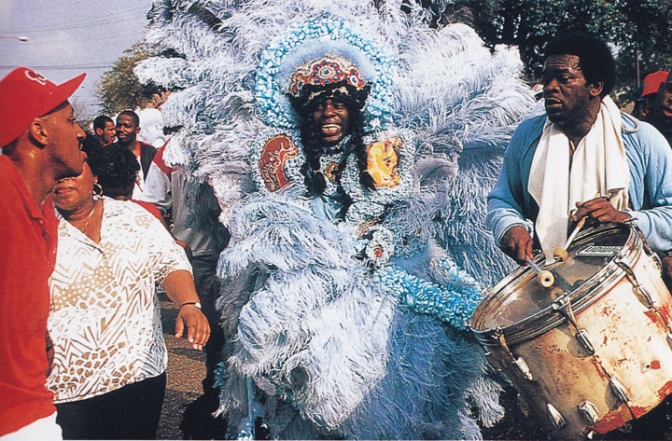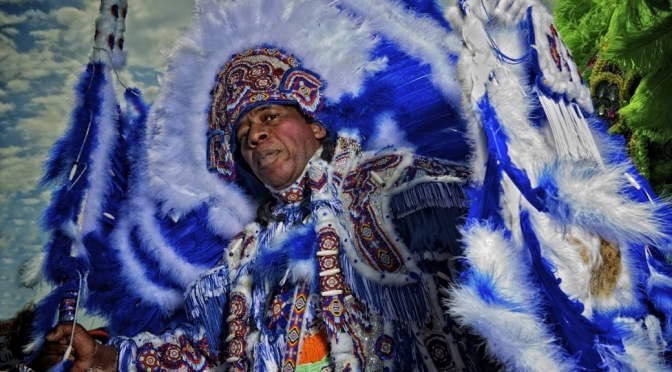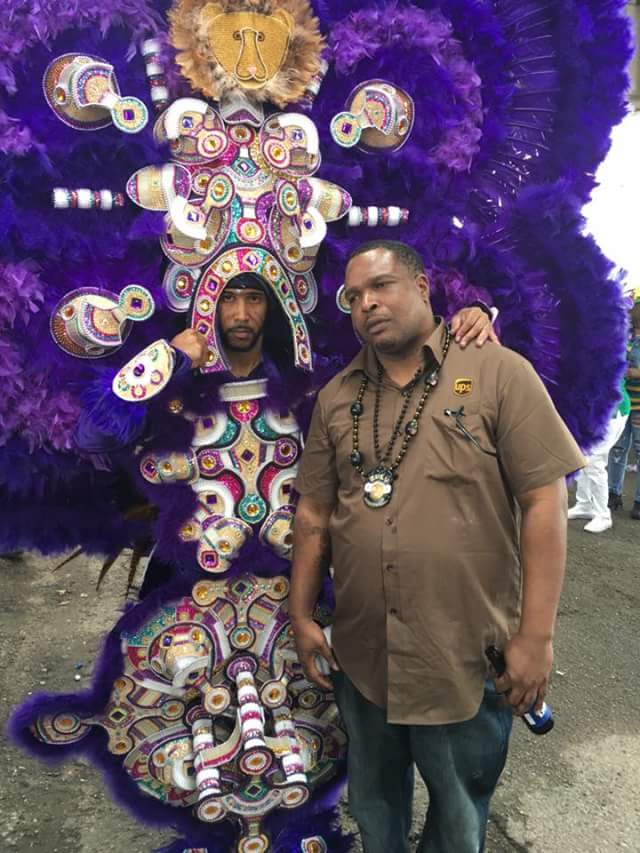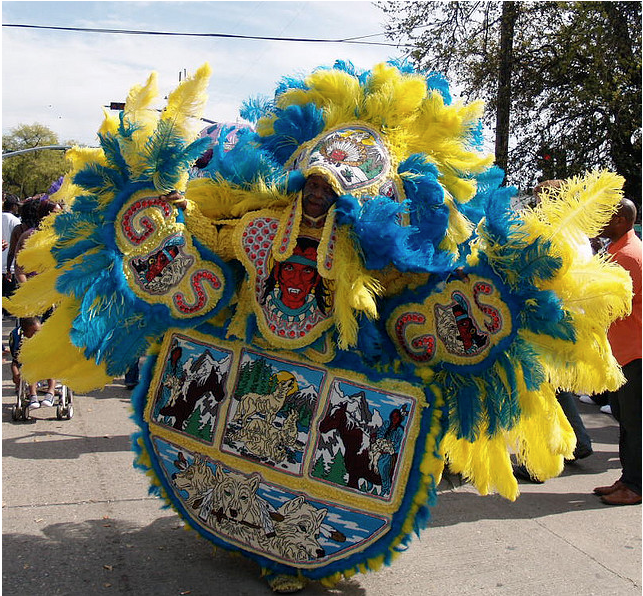Mardi Gras Indians are Black Carnival revelers in New Orleans, Louisiana, who dress up for Mardi Gras in suits influenced by Native Americanceremonial apparel.


Collectively, their organizations are called “tribes”. There are about 38 tribes. They range in size from half a dozen to several dozen members. The groups are largely independent, but a pair of umbrella organizations loosely coordinate the Uptown Indians and the Downtown Indians.
In addition to Mardi Gras Day, many of the tribes also parade on Saint Joseph’s Day (March 19) and the Sunday nearest to Saint Joseph’s Day (“Super Sunday”). Traditionally, these were the only times Mardi Gras Indians were seen in public in full regalia. The New Orleans Jazz & Heritage Festival began the practice of hiring tribes to appear at the Festival as well. In recent years it has become more common to see Mardi Gras Indians at other festivals and parades in the city.
Notwithstanding the popularity of such activities for tourists and residents alike, the fact remains that the phenomenon of the Mardi Gras Indians reflects both a vital musical history, and an equally vital attempt to express internal social dynamics.

Super Sunday 2018 Event
The New Orleans Mardi Gras Indian Council has announced official route info and the music lineup for Super Sunday events.
Super Sunday 2018 falls on March 18, the night before St. Joseph’s Day. Mardi Gras Indians from throughout the New Orleans area parade through Uptown, typically beginning around A.L. Davis park. The procession begins around 1 p.m., with a festival in the park beginning at 11 a.m., with food trucks and vendors on surrounding streets. Indians also take to the streets on St. Joseph’s night.
There are two stages with music and appearances from the Hot 8, Stooges and the Troop brass bands, with DJ Captain Charles, DJ Jubilee and DJ Maniac, Gina Brown, Rechell Cook, Lucky Lou and Da Crew, Ree Generation Band, the Young Men Olympians, Lady Buckjumpers, and B.R.W Singing Group.
Council Chief Howard Miller announced the route: from A.L. Davis park at Washington Avenue and LaSalle Street, it moves to Simon Bolivar Avenue, left on Martin Luther King Jr. Boulevard, left on Claiborne Avenue, and left on Washington to return to the park.
History
In 1740, New Orleans’ Congo Square was a cultural center for African music and dance. New Orleans was more liberal than many Southern cities, and on Sundays African slaves gathered to sing folk songs, play traditional music, and dance. The lively parties were recounted by a Northern observer as being “indescribable..The idea of letting loose and embracing traditional African music and dance is a backbone of the Mardi Gras Indians practice.

Native American and African American encounters
As a major southern trade port, New Orleans became a cultural melting pot.
During the late 1740s and 1750s, many African slaves fled to the bayous of Louisiana where they encountered Native Americans. Years later, after the Civil War, hundreds of freed slaves joined the U.S. Ninth Cavalry Regiment, also known as Buffalo Soldiers. The Buffalo Soldiers fought, killed, forced and aided the mass removal and relocation of the Plains Indians on the Western Frontier. After returning to New Orleans, many ex-soldiers joined popular Wild West Shows, most notably Buffalo Bill’s Wild West Show. The show wintered in New Orleans from 1884 to 1885 and was hailed by the Daily Picayune as “the people’s choice”. There was at least one black cowboy on the show, and numerous black cowhands.
On Mardi Gras in 1885, fifty to sixty Plains Indians marched in native dress on the streets of New Orleans. Later that year, the first Mardi Gras Indian gang was formed; the tribe was named “The Creole Wild West” and was most likely composed of members of Buffalo Bill’s Wild West Show, though the “Indian gangs” might predate their appearance in the parades.
Suits
Mardi Gras Indian suits cost thousands of dollars in materials alone and can weigh upwards of one hundred pounds. A suit usually takes between six and nine months to plan and complete. Each Indian designs and creates his own suit; elaborate bead patches depict meaningful and symbolic scenes. Beads, feathers, and sequins are integral parts of a Mardi Gras Indian suit. Uptown New Orleans tribes tend to have more sculptural and abstract African-inspired suits; downtown tribes have more pictorial suits with heavy Native American influences.
The rituals of these tribes aren’t for sale. In fact, very little profit comes from being a Mardi Gras Indian, but the love of New Orleans and the ancestry it affords is more than enough for the men and women keeping this tradition alive. Dressing up in full regalia to celebrate festivals like Super Sunday is a point of pride for them.


Parade formation and protocol
The Mardi Gras Indians play various traditional roles. Many blocks ahead of the Indians are plain clothed informants keeping an eye out for any danger. The procession begins with “spyboys,” dressed in light “running suits” that allow them the freedom to move quickly in case of emergency. Next comes the “first flag,” an ornately dressed Indian carrying a token tribe flag. Closest to the “Big Chief” is the “Wildman” who usually carries a symbolic weapon. Finally, there is the “Big Chief.” The “Big Chief” decides where to go and which tribes to meet (or ignore). The entire group is followed by percussionists and revelers.
During the march, the Indians dance and sing traditional songs particular to their gang. They use hodgepodge languages loosely based on different African dialects. The “Big Chief” decides where the group will parade; the parade route is different each time. When two tribes come across each other, they either pass by or meet for a symbolic fight. Each tribe lines up and the “Big Chiefs” taunt each other about their suits and their tribes. The drum beats of the two tribes intertwine, and the face off is complete. Both tribes continue on their way.

Violence
In the early days of the Indians, Mardi Gras was a day of both reveling and bloodshed. “Masking” and parading was a time to settle grudges. This part of Mardi Gras Indian history is immortalized in James Sugar Boy Crawford’s song, “Jock O Mo” (better known and often covered as “Iko Iko“), based on their taunting chants. However, in the late 1960s, Allison Montana, “Chief of Chiefs”, fought to end violence between the Mardi Gras Indian Tribes. He said, “I was going to make them stop fighting with the gun and the knife and start fighting with the needle and thread.” Today, the Mardi Gras Indians are not plagued by violence; instead they base their fights over the “prettiness” of their suits.
https://m.facebook.com/story.php?story_fbid=1862302927114793&id=100000053110158
Tribes of the Mardi Gras Indian Nation
- 7th Ward Creole Hunters
- 7th Ward Hard Headers
- 7th Ward Hunters
- 9th Ward Hunters
- Algiers Warriors 1.5
- Apache Hunters
- Black Cherokee
- Black Eagles
- Black Feather
- Black Hawk Hunters
- Black Mohawks
- Black Seminoles
- Blackfoot Hunters
- Burning Spears
- Carrollton Hunters
- Cheyenne Hunters
- Chippewa Hunters
- Choctaw Hunters
- Comanche Hunters
- Congo Nation
- Creole Osceola
- Creole Wild West
- Flaming Arrows
- Geronimo Hunters
- Golden Arrows
- Golden Blades
- Golden Comanche
- Golden Eagles
- Golden Star Hunters
- Guardians of the Flame
- Hard Head Hunters
- Louisiana Star Choctaw Nation
- Mandingo Warriors
- Mohawk Hunters
- Monogram Hunters
- Morning Star Hunters
- Northside Skull and Bones Gang
- Red Hawk Hunters
- Red Flame Hunters
- Red White and Blue
- Seminole Hunters
- Seminole (Mardi Gras Indian Tribe)
- Spirit of FiYiYi (aka Fi-Yi-Yi)
- Trouble Nation
- Unified Nation
- Uptown Warriors
- Washitaw Nation
- White Cloud Hunters
- White Eagles
- Wild Apache
- Wild Bogacheeta
- Wild Tchoupitoulas
- Wild Magnolias
- Wild Mohicans
- Yellow Pocahontas
- Yellow Jackets
- Young Navaho
- Young Brave Hunters
- Young Monogram Hunters
- Young Cheyenne
- Young Seminole Hunter
Super Sunday Parade
Start: Mar 18, 2018 12:00 PM
End: Mar 18, 2018 3:00 PM
A. L. Davis Park, Fourth St, New Orleans, LA 70113, USA
An example of a Super Sunday procession is as follows:
Begins at noon in A.L. Davis Park at Washington Avenue and LaSalle Street
Starts on LaSalle
Left at Martin Luther King Blvd
Left at Claiborne
Left at Washington Avenue
Ends back at A.L. Davis Park
The daytime parades make the Indians accessible to the general public and allow visitors and locals alike to admire their amazing costumes, crowns, and accessories. If time permits, make it a point to take part in this very unique New Orleans tradition.




